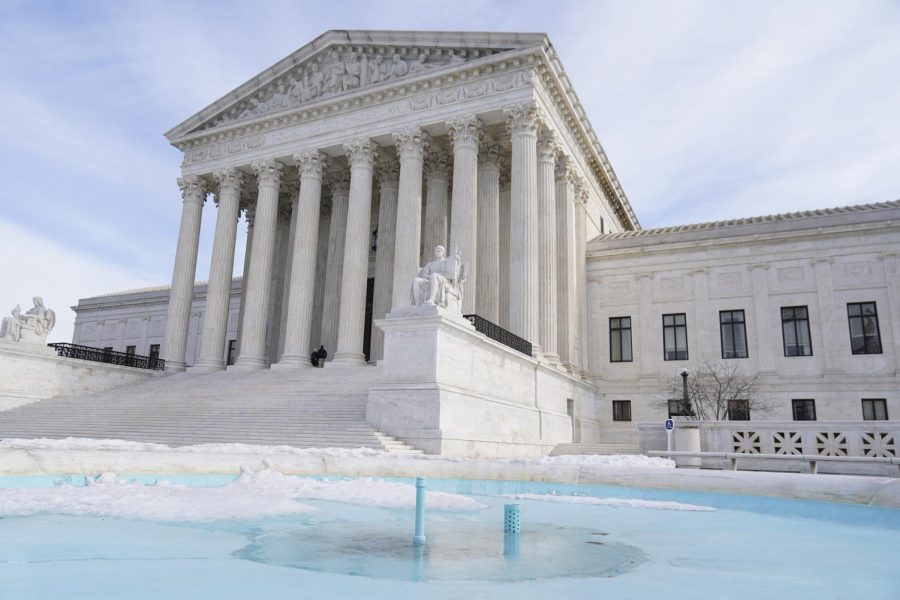The Supreme Court strikes down race-based admissions at Harvard College and the University of North Carolina
The U.S. Supreme Court on Wednesday, Jan.19, 2022, in Washington.
Jul 5, 2023
June 29, 2023, the Supreme Court announced its decision in two landmark cases regarding affirmative action at colleges and universities in the United States: Students for Fair Admissions (SFFA), Inc. v. President and Fellows of Harvard College and SFFA v. University of North Carolina, et al.
With a six-justice majority consisting of Chief Justice John G. Roberts Jr. and Justices Clarence Thomas, Samuel A. Alito Jr., Neil M. Gorsuch, Brett M. Kavanaugh, and Amy Coney Barrett, the Court overturned the admissions policies of both institutions on the grounds that they did not comply with the Equal Protection Clause of the Fourteenth Amendment. Justices Sotomayor and Kagan dissented in both cases and Justice Jackson dissented only in SFFA v. Harvard as she did not participate in the oral arguments for SFFA v. UNC.
The first noteworthy aspect of the majority opinion is that Chief Justice Roberts authored it. Typically, the Chief Justice of the Supreme Court tends to only author opinions in cases that are important to the law, in cases that are significant to the Chief Justice and their experiences or beliefs, or because it is a “landmark” case for the area of law.
The facts of the case are complex, as most cases before the Supreme Court are. The average Court follower only needs to know this: in 2014, SFFA sued both Harvard College and U.N.C. for violating the guarantees proscribed in the Equal Protection Clause of the Fourteenth Amendment due to the race-based admissions policies at both institutions, claiming that they privileged and dis-privileged White and Asian applicants based on their race. The constitutional question before the court was as follows: do the admissions policies of Harvard College and the University of North Carolina follow the Equal Protection Clause of the Fourteenth Amendment to the Constitution of the United States of America?
Chief Justice Roberts first addressed the issue of jurisdiction in this case. In short, does SFFA have the standing to sue the institutions, and does the Court have the proper jurisdiction? Roberts explained that, under the doctrine of representational and organizational standing created in Hunt v. Washington State Apple Advertising Commission (1977), SFFA has proper standing because the people it represents were effectively members of the organization at the time the suits were filed and that they could/would have filed suit on their own. In essence, this part of the opinion is Roberts asserting the foundations of the case are solid (SFFA v. Harvard (2023), pp. 6–9).
The opinion of the Court first emphasizes the importance of precedent in this decision by citing numerous rulings related to race-based admissions. In the legal world, this is called the doctrine of stare decisis, which roughly translates to let the decision stand.
Chief Justice Roberts references Brown v. Board of Education (I) (1954) and its ruling favoring desegregation of public schools and barring states from using race to determine educational opportunities to support the majority’s assertion that “[e]liminating racial discrimination means eliminating all of it.”
In the decision, the main issues with the admissions policies are related to strict scrutiny and precedent. Note, there is a hefty amount of dicta in this information that doesn’t relate directly to the central holding.
Chief Justice Roberts explains that strict scrutiny requires a compelling interest and the regulations in question must be narrowly tailored to serve that interest. This is the highest standard of judicial review executed by the court. Usually, strict scrutiny results in a loss for the party under review as they bear the heavy burden of proving their regulation satisfies the standard. Roberts states that the compelling interests presented by Harvard and UNC are not coherent enough for strict scrutiny and there is no meaningful connection between the means (admissions policies) and the goals (diversity and support for underprivileged racial groups). The Court cannot subject the policies to judicial scrutiny because there is nothing measurable; Roberts argues that there is no concrete measure of diversity.
Moreover, the categories created by the institutions are overbroad and underinclusive. This means that they capture too many racial groups in a category or do not include some in others. Robert argued that the admissions policies have a weak or non-existent, in his opinion, connection to the goals of a diverse student body. Additionally, Chief Justice Roberts claimed that these policies do not create diversity, in part because a member of a minority racial group does not share a minority opinion.
The decision relies heavily on two prior affirmative action cases, Regents of the University of California v. Bakke (1978) and Grutter v. Bollinger (2003). Roberts utilized Bakke to support the argument that race can only be considered as a positive factor in admissions, it cannot negatively impact an applicant. In Grutter, the Court accepted the argument that the university can discriminate in the interest of creating a more diverse study body, again saying that an applicant’s race must be measured as a plus instead. Roberts claimed Grutter states that, at some point, affirmative action must end. The Chief Justice then stated that neither school had any intention of ending race-based admissions; there was “no logical endpoint.”
These main points led the majority to override the previous decisions and end race-based admissions at Harvard College and the University of North Carolina.
However, Chief Justice Roberts exempts military academies from this ruling. Thus, West Point, for example, can still use race-based admissions because Roberts believes it is important to have a diverse officer corps leading a diverse military.
Outside the majority opinion, Justice Thomas concurred with Chief Justice Roberts and took an originalist approach to the constitutional question, emphasizing the wording of the Equal Protection Clause and its original meaning. Justice Thomas also explained his support for the idea that the “Constitution is colorblind.”
Justice Gorsuch concurred and Justice Thomas joined his concurrence. He authored this concurrence to assert that he believes the admissions policies also violate Title VI of the Civil Rights Act of 1964. Furthermore, Justice Kavanaugh concurred with the majority opinion. He emphasized the importance of adhering to precedent in the Court’s decisions.
Justice Sotomayor, joined by Justices Kagan and Jackson, dissented from the majority opinion. She argued that the Fourteenth Amendment and the Equal Protection Clause guarantee racial equality under the law. Moreover, she claims that the Court is rolling back the precedent from Brown, and “colorblindness” ignores the fact that race has always mattered in this country.
Justice Jackson claimed that there are benefits to considering race in the admissions process and that the country has never been colorblind, which is the issue that the admissions processes seek to address.
Given that Harvard is a private college and UNC is a public university, this case will impact almost all institutions of higher education across the country. The Constitution applies to UNC as it is a public, state-funded university, and to Harvard as it receives federal funding. Applicants can write about the adversity they have endured as a result of their race in their essays. Yet, this decision means that any institution that receives federal funding cannot use affirmative action as it previously did.
You can view the full opinion here.













